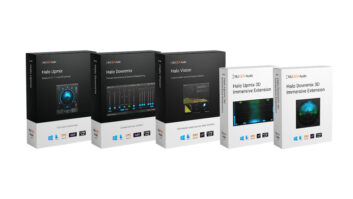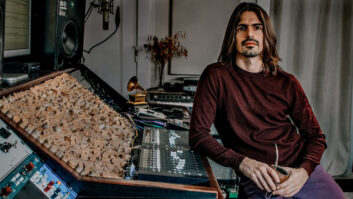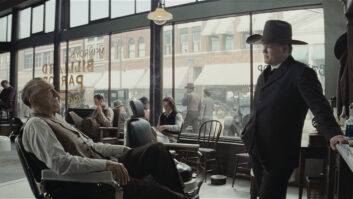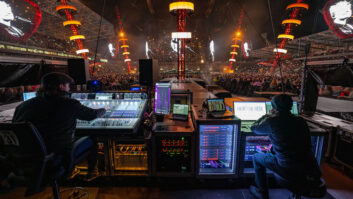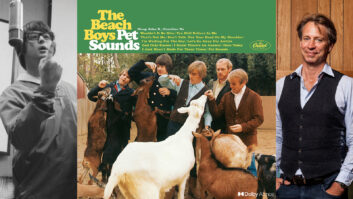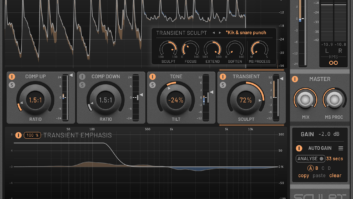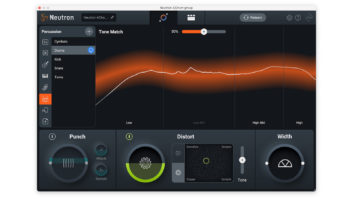
Deep down, every experienced audio engineer knows that it’s true: Working within strict limitations can be the best thing that ever happened to a project.
The same goes for indie movie producers like Gregory Horoupian, who got a solid reminder of that adage while producing an engrossing new short film called Enigma. The hard limit? There would be only 90 minutes to complete the 13-minute production’s stereo mix. “I learned this a long time ago: You do better with constraints,” Horoupian says. “So I took a deep breath and said, ‘How are we going to do this? I don’t know, but we have no choice.’”
First-time director Claudine Eriksson is currently a BFA student at New York City’s School of Visual Arts. But she had some notable help in producing the movie, which is about a successful and driven book publisher in her 40s who comes across the work of a young up-and-coming photographer—only to have their professional relationship disrupted by the inevitable connection to each other. Eriksson’s cowriter on the screenplay was Alexander Dinelaris, Jr., who just won an Academy Award for Best Original Screenplay for the 2014 film Birdman. Another elite credit is Executive Producer Bob Giraldi, the award-winning director responsible for the film Dinner Rush and Michael Jackson’s famed Beat It video.

With talent like this working behind the scenes, Horoupian and Eriksson are betting on success, which meant they had to plan for a future 5.1 surround mix, as well as the stereo mix they would be executing under the severe time crunch.
Pre-Production
The responsibility of having all sonic elements in readiness fell to Humberto Corte, Enigma’s sound designer/supervising sound editor. The founder of Vancouver-based post facility Parlante Sound, Corte has worked on countless features, TV shows, short films and commercials; he was prepared to handle a rush job.
“I like to be a part of the workflow pretty much from the beginning,” Corte says. “When I get a script, I make a quick cue sheet with the main elements that are mentioned, so I can start recording as they go. I also like watching rough cuts so I can plan for the time, as well as the people, that I will probably need to be a part of my team.”
Eventually, Corte would deliver a comprehensive range of Pro Tools sessions for the mix: eight dialog tracks, 16 background tracks, four music tracks, and 24 tracks of sound effects. Each individual element was pre-organized into banks to be ready for use in a stereo mix, or the anticipated 5.1 session down the line. But before the audio would be ready to arrive at the NYC facility limeBeat for mixing, Corte worked meticulously to make sure everything would be ready to go.
First were the obvious tasks, which included Parlante Sound dialog editor Miguel Araujo cleaning up recordings from numerous noisy NYC locations. When it came to sound effects, however, Corte pulled a couple of unconventional moves, which started with premixing those elements.
“I expected that limeBeat’s re-recording mixer, Mattias Murhagen, was going to spend the whole time working on dialog, so I wanted to give him the least work possible in terms of sound effects,” Corte explains. “That meant doing simple stuff like printing reverb into the sound effects and background ambiences. Usually everything is delivered raw to the mix stage, but things were so tight I said, ‘I might as well do it; they won’t have time to like it or not like it!’”

Another of Corte’s contributions with the sound effects was as counterintuitive as it was effective: Instead of providing just one sound effect at a given moment, Corte actually speeded things up by providing as many choices as possible.
“I added a lot of sounds,” he says, “not to distract, but to allow the mixer to do different things when he needed to cover up the sound of clothes rustling, for example. By having a lot of options available, the mixer would have the ability to make it work the way he thought was best. So even if I didn’t think they would want a particular sound, I kept it in the session in case it might help the mix in some way.”
Ready, Set, Mix
When mix day arrived, Eriksson and Horoupian joined Murhagen in his suite at limeBeat’s picturesque facility in NYC’s Flatiron district, while Corte attended via phone from Vancouver. As the pressure-packed 90-minute stereo session unfolded, it became clear that success would depend as much on personality as it would Pro Tools mastery.
“None of us are frantic people, but we knew we had a set amount of time there,” Horoupian recalls. “It was definitely, ‘Let’s go!’ But Mattias understood the situation as well, and at this stage he was the captain of the ship. He was very calming, he did the work, and by the time we stepped out of there it was like, ‘Wow! We did it!’”
With the stereo mix in the can, the team emerged from limeBeat prepared to do the 5.1 mix when time and budget would allow. “The DAW session is set up as a dual edit,” Corte notes. “There are tracks everywhere, to be open for whatever comes next for this film. Looking ahead to when we go to 5.1, I created 4-channel backgrounds that will surround the viewer in a certain way, for example. The sound will really open up.”
As Enigma starts to make its way through the festival circuit, time will tell if viewers and movie execs connect to its intriguing story. Until then, a primary measure of the sound crew’s success is how well the soundtrack translates the director’s vision.
“I’m extremely happy with the results,” Eriksson says. “The sound creates the tone and the atmosphere, but it’s also invisible in the right places. It tells the story and improves it in every way. We landed exactly where we should be.”
